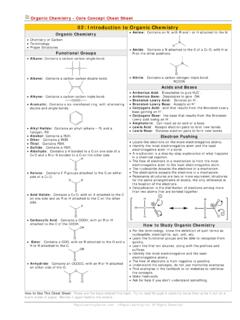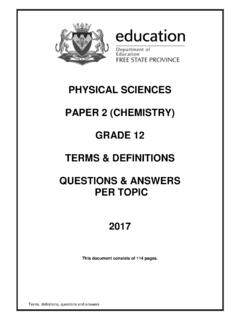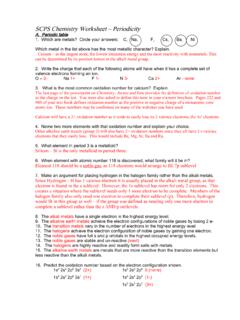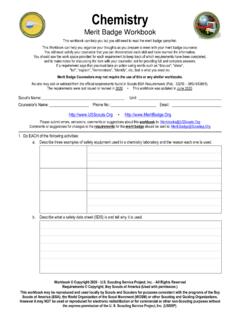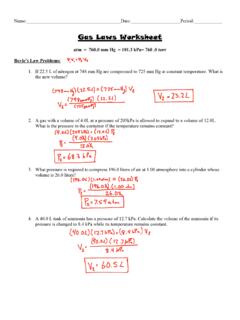Transcription of High School Chemistry Rapid Learning Series
1 1|Page High School Chemistry Rapid Learning Series Course Study Guide All rights Reserved, Rapid Learning Inc. Rapid Learning Inc. All Rights Reserved 2|Page Introduction to High School Chemistry High School Chemistry is often a student's first exposure to Chemistry . You may not even be sure what Chemistry really is. Many High Schools and Colleges are now requiring students to take High School Chemistry . This Series will introduce you to the basic concepts and problem solving included every High School Chemistry Course, typically a two-semester class. Learning Chemistry is about the understanding of the key concepts and the application of these concepts onto problem solving in Chemistry . These two key ingredients are also the focus of this course.
2 Unlike traditional textbooks, this Rapid Learning Series will introduce you the Chemistry via visual Learning and smart teaching. There are total of 24 chapters in this course, each chapter will require the study of three components: core tutorial, problem drill and review sheet. Let us put some real effort to learn Chemistry , one hour at a time. Execute your study plan and carry your Learning to the finish line. Rapid Learning Inc. All Rights Reserved 3|Page Table of Contents Core Unit #1 Introduction to the Tools of Chemistry In this core unit, you will build the basics to Chemistry mastery. With these skills, you will form a solid foundation to understand Chemistry and problem solving. Tutorial 01: Introduction to Chemistry The Metric and SI Systems Measurement and Uncertainty Significant Figures Fundamental Constants used in Chemistry Brief overview of topics to be included in future tutorials Tips for studying Chemistry Tutorial 02: Math for Chemistry Algebra Calculating with significant figures Scientific Notation Logarithms Calculator tips Tutorial 03: Dimensional Analysis (Factor-Label Method).
3 What is dimensional analysis? What equalities are used commonly in Chemistry ? How is dimensional analysis performed? How is dimensional analysis used in Chemistry ? Tutorial 04: Solving Chemistry Problems in Chemistry General Problem solving technique Problem solving technique for word problems Preparing for tests Taking test Tutorial 05: Matter & Energy Definition of Chemistry Matter Energy Changes Properties Scientific Process Core Unit #2 Atoms, Molecules and Reactions In this core unit, you will learn the language of Chemistry and basic calculations. Tutorial 06: Pure Substances: Atoms and Molecules Atoms Ions Element Symbols Isotopes Atoms, Elements, and Molecules Tutorial 07: Writing Chemical Formulas Binary Ionic Formulas Polyatomic Ionic Formulas Rapid Learning Inc.
4 All Rights Reserved 4|Page Ionic with multivalent metals Formulas Binary Covalent Formulas Acids Formulas Tutorial 08: Naming Chemical Compounds Binary Ionic Naming Polyatomic Ionic Naming Ionic with Multivalent Metals Naming Binary Covalent Naming Acids Naming Tutorial 09: Counting Molecules: The Mole The Mole Molar Mass Percent Composition Empirical formulas Molecular formulas Tutorial 10: Chemical Reactions Components of a chemical reaction Common types of chemical reactions Determine products of a double replacement reaction Using solubility rules to determine a precipitate Tutorial 11: Balancing Equations Using The Law of Conservation of Mass to balance the equations Choosing which atom to begin balancing with Inspection method of balancing Tutorial 12 The Math of Chemical Equations: Stoichiometry Review of: Chemical equations; Dimensional Analysis; KUDOS method; Molarity Mole-Mole problems Mole-mass problems Mass-mass problems Mole-volume problems for solutions Mole-volume problems for gases Core Unit #3 The Electronic Structures In this core unit, you will learn the building blocks for Chemistry and the most important concept.
5 Electrons. Tutorial 13: Electron Configuration Atomic structure Electron configurations Tutorial 14: The Periodic Table Periodic table Periodicity Ionic Radii Tutorial 15: Chemical Bonding Types of Bonding & Characteristics Valence Bonding Theory Tutorial 16: Drawing Molecules Review of bonding Rapid Learning Inc. All Rights Reserved 5|Page Lewis Structures Tutorial 17: Molecular Geometry Valence Shell Electron Pair Repulsion Theory Determining electron geometry Determining molecular geometry Core Unit #4 States of Matter In this core unit, you will be introduced to two states of matter gases and solutions Tutorial 18: The Gas Laws Pressure Temperature Kinetic Molecular Theory Explanations of gas behavior Gas laws Gas stoichiometry Real Gases Tutorial 19: Solutions Process of solution formation Factors affecting solubility Concentration calculations Electrolyte solutions Colloids Core Unit #5 The Control of Chemical Reactions In this core unit, you will learn all about the reactions and their energetics.
6 Tutorial 20: Equilibrium & Rates of Reaction Collision Theory Reaction Coordinate Diagrams Factors affecting rate Dynamic equilibrium Equilibrium constant Reaction quotient Le Chatelier's principle Tutorial 21: Acids and Bases Acids and base definitions Properties of acids and bases Strong versus weak acids and bases pH scale Acid and base properties of salts Buffers Titrations Tutorial 22: Energy & Physical Changes Energy, temperature and heat Specific heat capacity Heats of fusion & vaporization Heating curves Calorimetry Tutorial 23: Energy & Chemical Changes Rapid Learning Inc. All Rights Reserved 6|Page Energy, temperature and heat Heat of reaction Heat of formation Hess's Law Calorimetry Entropy Free Energy Tutorial 24: Electrochemistry Oxidation numbers Balancing redox reactions (oxidation number method & Half-reaction method).
7 Voltaic cells Cell potentials Electrolytic cells Rapid Learning Inc. All Rights Reserved 7|Page Tutorial Series Features This tutorial Series is a carefully selected collection of core concept topics in high School Chemistry that covers the essential concepts and problem solving. It features three core parts: Concept Tutorials 24 essential topics Problem-Solving Drills 24 practice sets Super-Review Cheat Sheets 24 super review sheets Core Component#1: Visual Tutorials (x24). Self-contained tutorials, not just an outline Concept map showing inter-connections of related concepts Definition slides introduced contextually Visual representation of new concepts Molecular visualization of structures Molecular animations of reactions Animated problem solving step by step A concise summary Core Component #2: Problem-Solving Drills (x24).
8 Chapter-related problems Feedback-based drills Intereactive on every click Complete solutions at the end Review and retake at will Core Component #3: Super-Review Sheets (x24). Key concepts and formulas for the chapter One-page summary sheet per chapter Printable in PDF. Supplemental Component #1: Printable eBooks (x24). Well formatted printable tutorials One eBook per chapter with total of 24. Easy reading for re-cap and final review Supplemental Component #2: Audiobooks (x24). Learning on-to-go 24 mp3 audiobooks for 24 chapters Enhancement to visual Learning Immersion study anywhere anytime Rapid Learning Inc. All Rights Reserved 8|Page 01: Introduction to Chemistry Tutorial Summary The Metric and SI (International System) of units is used throughout Chemistry .
9 The metric system is based on prefixes showing the power of 10 used with base units describing the quantity measured. Chemistry is an experimental science; therefore it is necessary to take careful measurements. Measurements should always include one more decimal place than the instrument indicates for certain this last decimal place should be a 0 if the measurement is on the line and a 5 if the measurement is in-between the lines. Most measurements are understood to be +/- 1 in the last decimal place, unless another uncertainty value is given with the measurement. Once careful measurements are taken, the precision with which they were measured can not be heightened while doing calculations, nor should it be lost and allowed to become less precise.
10 Therefore, there are rules about counting significant figures which indicate which were measured for certain. Rules on performing calculations with significant figures will be introduced in a later tutorial. There are many other Basic skills needed in Chemistry , but they will be introduced throughout the tutorial Series when they are needed. Tutorial Features Concept map showing inter-connections of new concepts in this tutorial and those previously introduced. Definition slides introduce terms as they are needed. Visual representation of concepts. Animated examples worked out step by step. A concise summary is given at the conclusion of the tutorial. Concepts Covered The Metric and SI Systems o Metric prefixes o SI units o Common non-SI units Measurement and Uncertainty o Tools common in Chemistry Labs o Taking measurements o Uncertainty Significant Figures o Why they're used o How to count them Fundamental Constants used in Chemistry Brief overview of topics to be included in future tutorials: o The language of Chemistry o The periodic table o Dimensional analysis o Scientific notation o Use of scientific calculators Tips for Studying Chemistry Content Review Chemistry is an experimental science; therefore it is necessary to be able to work with units and measurements accurately.
